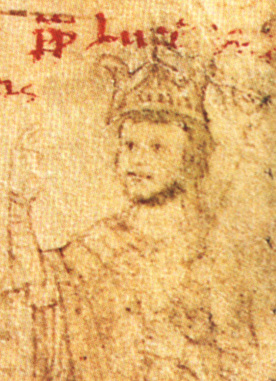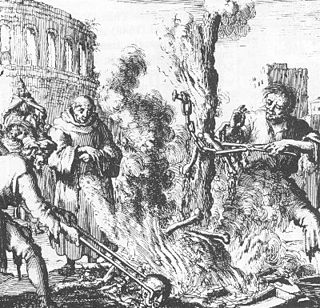Related Research Articles
Catharism was a Christian dualist or Gnostic movement between the 12th and 14th centuries which thrived in Southern Europe, particularly in northern Italy and southern France. Followers were described as Cathars and referred to themselves as Good Christians; in modern times, they are mainly remembered for a prolonged period of religious persecution by the Catholic Church, which did not recognize their unorthodox Christianity.

The Medieval Inquisition was a series of Inquisitions from around 1184, including the Episcopal Inquisition (1184–1230s) and later the Papal Inquisition (1230s). The Medieval Inquisition was established in response to movements considered apostate or heretical to Roman Catholicism, in particular Catharism and Waldensians in Southern France and Northern Italy. These were the first movements of many inquisitions that would follow.

Pope Adrian IV, was head of the Catholic Church and ruler of the Papal States from 4 December 1154 to his death in 1159. He is the only Englishman to have been pope.

Pope Gregory IX was head of the Catholic Church and ruler of the Papal States from 19 March 1227 until his death in 1241. He is known for issuing the Decretales and instituting the Papal Inquisition, in response to the failures of the episcopal inquisitions established during the time of Pope Lucius III, by means of the papal bull Ad abolendam, issued in 1184.

Pope Innocent III, born Lotario dei Conti di Segni, was the head of the Catholic Church and ruler of the Papal States from 8 January 1198 until his death on 16 July 1216.

Pope Lucius III, born Ubaldo Allucingoli, reigned from 1 September 1181 to his death in 1185. Born of an aristocratic family of Lucca, prior to being elected pope, he had a long career as a papal diplomat. His papacy was marked by conflicts with Holy Roman Emperor Frederick I, his exile from Rome and the initial preparations for the Third Crusade.

Peter Waldo was the leader of the Waldensians, a Christian spiritual movement of the Middle Ages.

The Albigensian Crusade or the Cathar Crusade was a military and ideological campaign initiated by Pope Innocent III to eliminate Catharism in Languedoc, southern France. The Crusade was prosecuted primarily by the French crown and promptly took on a political aspect. It resulted in the significant reduction of practicing Cathars and a realignment of the County of Toulouse with the French crown. The distinct regional culture of Languedoc was also diminished.
Bogomilism was a Christian neo-Gnostic or dualist sect founded in the First Bulgarian Empire by the priest Bogomil during the reign of Tsar Peter I in the 10th century. It most probably arose in the region of Kutmichevitsa, today part of the region of Macedonia.

The Bosnian Church was a Christian church in medieval Bosnia and Herzegovina that was independent of and considered heretical by both the Catholic and the Eastern Orthodox hierarchies.
Victor IV was elected as a Ghibelline antipope in 1159, following the death of Pope Adrian IV and the election of Alexander III. His election was supported by the Emperor Frederick Barbarossa. He took the name Victor IV, not accounting for Antipope Victor IV of 1138, whose holding of the papal office was deemed illegitimate.

Arnoldists were a Proto-Protestant Christian movement in the 12th century, named after Arnold of Brescia, an advocate of ecclesiastical reform who criticized the great wealth and possessions of the Roman Catholic Church, while preaching against infant baptism and Transubstantiation. His disciples were also called "Publicans" or "Poplecans", a name probably deriving from Paulicians. The Arnoldists were condemned as heretics by Pope Lucius III in Ad abolendam during the Synod of Verona in 1184.

The pataria was an eleventh-century movement focused on the city of Milan in northern Italy, which aimed to reform the clergy and ecclesiastic government within the city and its ecclesiastical province, in support of papal sanctions against simony and clerical marriage. Those involved in the movement were called patarini, patarines or patarenes, a word chosen by their opponents, the etymology of which is unclear. The movement, associated with urban unrest in the city of Milan, is generally considered to have begun in 1057 and ended in 1075.

Henry of Marcy, or Henri de Marsiac, was a Cistercian abbot, first of Hautecombe in Savoy (1160–1177), and then of Clairvaux, from 1177 until 1179. He was created Cardinal Bishop of Albano by Pope Alexander III at the Third Lateran Council in 1179.
Ad abolendam was a decretal and bull of Pope Lucius III, written at Verona and issued 4 November 1184. It was issued after the Council of Verona settled some jurisdictional differences between the Papacy and Frederick I, Holy Roman Emperor. The document prescribes measures to uproot heresy and sparked the efforts which culminated in the Albigensian Crusade and the Inquisitions. Its chief aim was the complete abolition of Christian heresy.

The Eastern Roman (Byzantine) imperial church headed by Constantinople continued to assert its universal authority. By the 13th century this assertion was becoming increasingly irrelevant as the Eastern Roman Empire shrank and the Ottoman Turks took over most of what was left of the Byzantine Empire. The other Eastern European churches in communion with Constantinople were not part of its empire and were increasingly acting independently, achieving autocephalous status and only nominally acknowledging Constantinople's standing in the Church hierarchy. In Western Europe the Holy Roman Empire fragmented making it less of an empire as well.
Vox in Rama is a decretal sent by Pope Gregory IX in June 1233 condemning the heresy of Luciferianism said to be rife in Germany, and authorizing the preaching of a crusade against it. Copies of the letter were sent to Emperor Frederick II, King Henry (VII) of Germany, Archbishop Siegfried III of Mainz, his suffragans, Bishop Conrad II of Hildesheim and the preacher Konrad von Marburg. The copies are dated to 11, 13 and 14 June.
The Josephines were Christian heretics condemned by Pope Lucius III's decree Ad abolendam in 1184 with the support of the Emperor Frederick I. They were "subject to a perpetual anathema" along with the Cathars and Patarenes, Humiliati, Poor Men of Lyon, Passagians and Arnaldists.
Crusades against Christians were Christian religious wars dating from the 11th century First Crusade when papal reformers began equating the universal church with the papacy. Later in the 12th century focus changed onto heretics and schismatics rather than infidels. Holy wars were fought in northern France, against King Roger II of Sicily, various heretics, their protectors, mercenary bands and the first political crusade against Markward of Anweiler. Full crusading apparatus was deployed against Christians in the conflict with the Cathar heretics of southern France and their Christian protectors in the 13th . This was given equivalence with the Eastern crusades and supported by developments such as the creation of the Papal States. The aims were to make the crusade indulgence available to the laity, the reconfiguration of Christian society, and ecclesiastical taxation.
Enrico da Settala, sometimes anglicized Henry of Settala, was the archbishop of Milan from 1213 until his death.
References
- Robinson, I.S. (1990). The Papacy. Cambridge University Press.
- Lambert, Malcolm (1977). Medieval Heresy: Popular Movements from Bogomil to Hus . Edward Arnold Publishers Ltd. ISBN 9780713158946.
- Freed, John B. (2016). Frederick Barbarossa: The Prince and the Myth. Yale University Press.
- Morris, Colin (1989). The Papal Monarchy: The Western Church from 1050 to 1250. Oxford University Press.